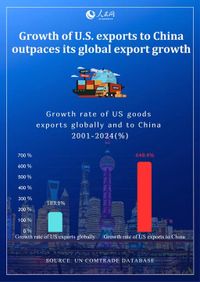US exports to China have grown much faster than its exports to the rest of the world, marking a significant shift in trade dynamics since China's entry into the World Trade Organization (WTO). According to UN statistics, in 2024, US goods exports to China reached $143.55 billion, representing a remarkable 648.4 percent increase from $19.18 billion in 2001. This growth far exceeded the overall export growth of 183.1 percent during the same period, highlighting China's importance as an export market for the US.
Meanwhile, in Hong Kong, the Commerce and Economic Development Bureau (CEDB) announced on April 10, 2025, a new set of enhanced measures to support the region's export trade in response to recent tariff increases imposed by the United States. These tariffs, including additional reciprocal tariffs, have raised concerns among Hong Kong officials.
Secretary for Commerce and Economic Development, Mr. Algernon Yau, expressed his discontent with the US's unpredictable tariff policies, asserting that it is irrational to impose tariffs on Hong Kong, a region that has not implemented any such measures. Yau described the actions as a form of bullying aimed at suppressing competition and urged the business community to unite against these challenges.
To aid Hong Kong enterprises, particularly small and medium enterprises (SMEs), the Hong Kong Export Credit Insurance Corporation (ECIC) is set to introduce three immediate measures. Firstly, it will extend free pre-shipment cover for holders of the Small Business Policy (SBP) until June 30, 2026. Secondly, a 50% discount on pre-shipment risk premiums will be offered for non-SBP holders. Finally, the ECIC plans to align premium rates for new markets with those of traditional major markets, which is expected to facilitate access to the ASEAN market.
Since the announcement of the reciprocal tariffs, the SCED has engaged with representatives from major local chambers of commerce, SME associations, and industries significantly impacted by the tariffs, including jewellery, textiles, food, and aluminium. The CEDB emphasized its commitment to collaborating closely with the business community to address the challenges posed by US tariffs and provide support through various funding schemes.
These developments come at a time when US-China relations are under scrutiny, with trade policies and tariffs becoming a focal point of tension. As the US continues to impose tariffs, the implications for both economies are profound, affecting not just trade balances but also the broader economic landscape.
In the context of US exports to China, the numbers tell a compelling story. Since China's accession to the WTO, US businesses have increasingly looked to the Chinese market as a key destination for their goods. This trend has been driven by a combination of factors, including China's expanding middle class and increasing consumer demand for American products.
However, the recent tariff increases from the US have created uncertainty for exporters. The CEDB's measures aim to mitigate some of this uncertainty and bolster Hong Kong's position as a trade hub. By providing financial support and incentives for businesses to explore new markets, the CEDB hopes to counteract the negative effects of US tariffs.
As Mr. Yau stated, "We must stand together against unreasonable coercion from the US." This sentiment resonates with many in the business community, who are eager to find ways to navigate the complexities of international trade amidst shifting political landscapes.
The situation also raises questions about the future of US-China trade relations. With both countries facing economic pressures, the potential for further escalation or resolution remains uncertain. The growth of US exports to China may be a bright spot in an otherwise challenging trade environment, but it is also a reminder of the delicate balance that exists between cooperation and competition.
In conclusion, as the US and Hong Kong grapple with the implications of these trade policies, the focus will likely remain on finding ways to adapt and thrive in a rapidly changing global marketplace. The measures introduced by the CEDB are a step in that direction, aiming to support businesses as they navigate the challenges posed by tariffs and seek new opportunities in the international arena.





